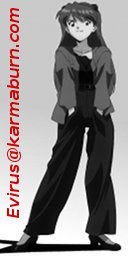|
|
Blog Archives:
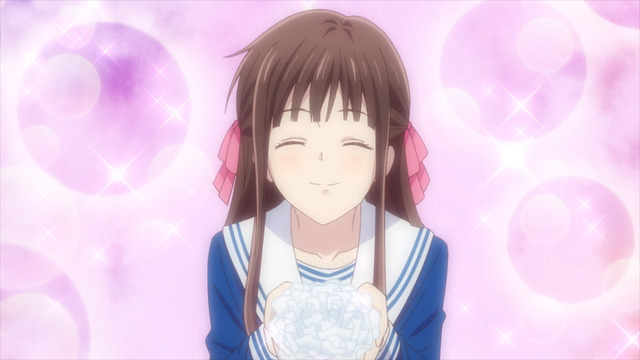
This is how everyone sees Honda Tohru and yet people
still manage to be assholes to her.
It's sort of difficult to talk about Fruits Basket: The Final because it's a 13-episode conclusion in a 63-episode adaptation of a well-regarded 23-volume manga. It's also a do-over succeeding a 26-episode series from 20 years ago which was also really good even though the source material hadn't ended yet. So, there's a lot going on.
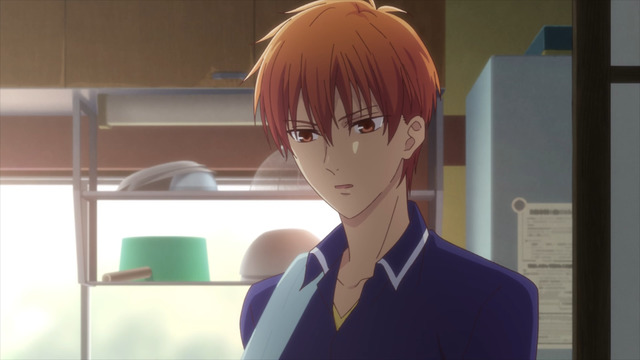
Is cat.
I do wish I had paid closer attention when I started watching this iteration of Fruits Basket when it began in 2019. There are a lot of characters, and there is a lot of setup, and I'm certain I missed a lot of subtleties early on. I suppose that is an argument in favor of re-watching the series, even if it is 63 episodes long, but that isn't going to happen until I've finally gotten around to reading the source material. It's gonna be a while.
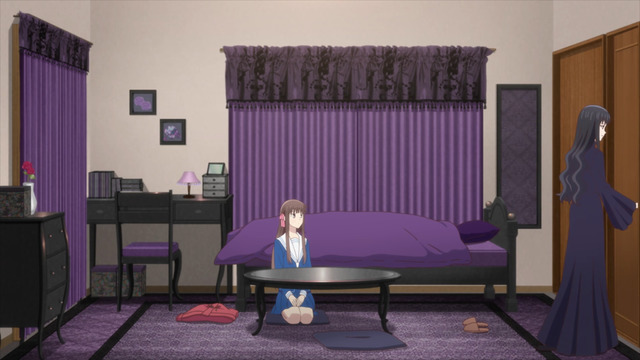
This bedroom is fantastic.
Probably everyone who has heard about Fruits Basket also knows opinions about it are almost universally favorable. Likewise, anyone thinking about getting into the series probably knows at least as much as I did concerning what it's ostensibly "about" before I watched the first anime (the 2001 one with Hocchan). One thing that surprised me as I got deeper into the plot is how monstrous the zodiac aspects are regarded in-universe. They're not set up that way at the start of the series at all.
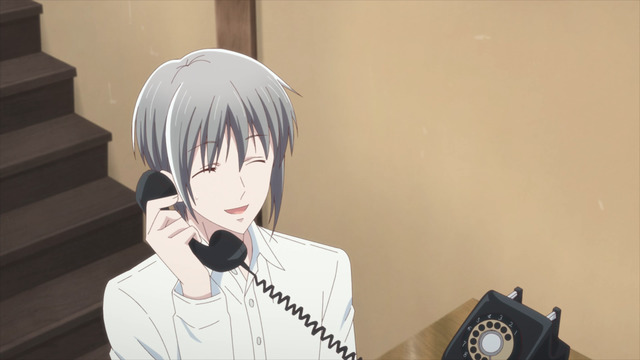
Look, a rotary phone.
I don't really want to write about Fruits Basket, since it's basically one of those shows where you can just sort of say, "Look, everyone says it's good. It is good. Just watch it." I can also see how it might not be for everyone. You have to have to have an appetite for romance and a tolerance for assholes. So many assholes. Honda Tohru is, like, the nicest, sweetest, goodest girl in the entire world and she's constantly surrounded by bitches being bitches and assholes being assholes. Back the fuck away from Honda Tohru, people.
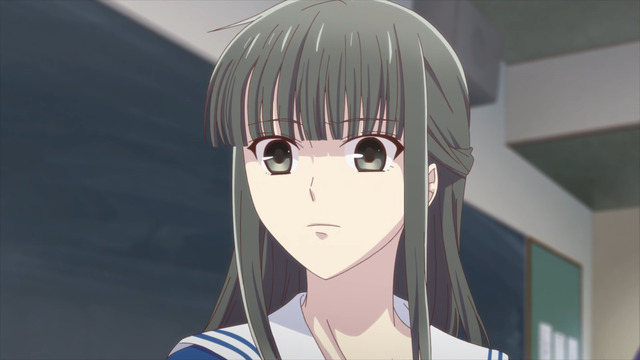
People are also assholes to Machi.
I guess viewers also have to be okay with "problematic" 'ships. I don't know if this heightened anxiety is an actual sign of the times, or if it's just localized sensitivity found on the Twitter. There are multiple age-gap pairings. There are people being mean to the people they love. Honda Tohru's mom dies. It's a whole thing. I guess the Fruits Basket 'ships are less "problematic" than the ones in Card Captor Sakura, but if these are the sorts of things that genuinely bother you, shoujo might not be for you.
Posted in Fruits Basket, RECOMMENDATIONS | Tags: 16-year-old love interests, Bedrooms, CATS, Crying, Ensemble Cast, Kugimiya Rie, Love Confessions, Love Triangle, May-December Romances, Plying Girls, Romance, Season Conclusion, Season Introduction, Sex, Shoujo, Spoilers, Spring 2019, Spring 2020, Spring 2021, Summer 2019, Summer 2020, tsundere, Twitter, Unrequited Love, Yui Horie | Permanent Link
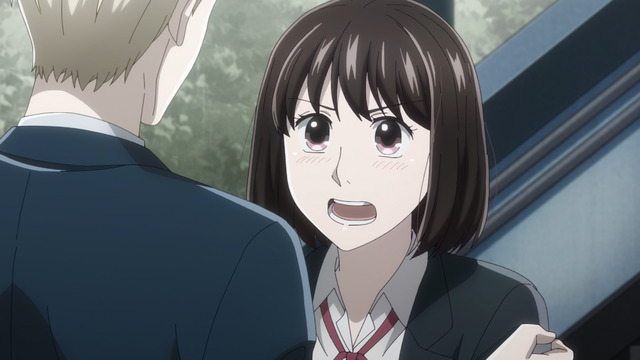
They're not flirting.
I started the Spring 2021 season with an entry covering both Koi to Yobu ni wa Kimochi Warui (It's Disgusting to Call This Love or KoiKimo) and Hige wo Soru. Soshite Joshikousei wo Hirou. (I Shaved. Then I Brought a High School Girl Home. or HigeHiro), so I guess I should have a post wrapping them up as well. I found KoiKimo to be a better series, perhaps because of its straightforward story. It also helps that KoiKimo leaves Ichika in control of her fate. It is ultimately Ichika's decision whether her relationship with Ryo will advance or not.
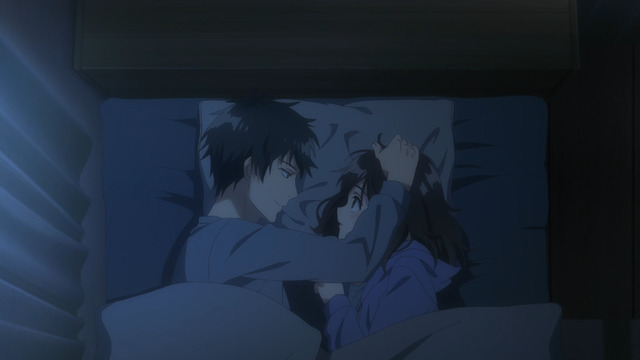
Platonic head pat.
Sayu does not have this luxury in HigeHiro. Maybe it's disingenuous to claim HigeHiro is about Yoshida "looking for something attractive to save" (my apologies to Liz Phair), but replace Yoshida's name here with "the audience's surrogate," and maybe it's not far off the mark. KoiKimo and HigeHiro both ended up where I expected, but Sayu had much less say over the path she took to get there.
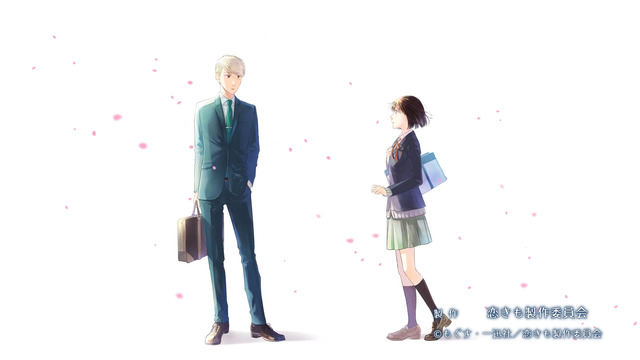
Making the end credits look more like the manga art was a nice touch.
In contrast, KoiKimo is an honest romance. There is no real mystery whether Ichika and Ryo will actually end up together or not, even though KoiKimo does introduce rival love interests for both leads. Moreover, the rivals are genuinely more sensible partners from every objective metric. However, the most obvioius impediment—the age gap between Ichika and Ryo—is never depicted as a meaningful obstacle. When it is finally viewed as a problem, its solution is entirely unsurprising.
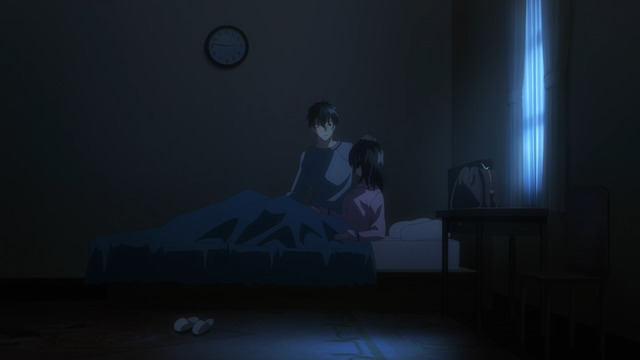
Platonic head pat.
The solutions to the challenges presented in HigeHiro are also fairly obvious, but the series insists on pantomiming a number of unconvincing feints. They're unconvincing because Sayu basically has no flaws, and Yoshida clearly feels something for her. He never has a reason to turn her away, and Sayu's rivals for Yoshida's attention are dubious love interests who quickly end up supporting Sayu anyway.
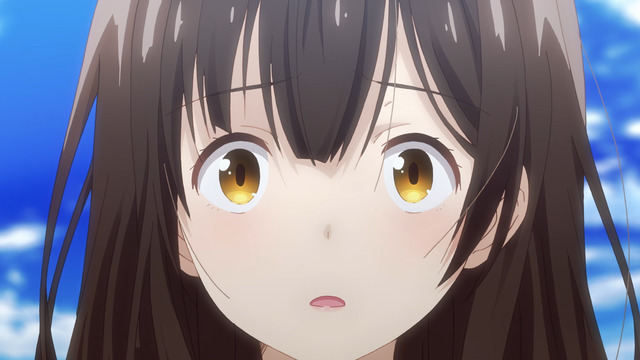
Relax, Sayu. Wonder Eggs are only 500 yen each.
In fact, Sayu's true adversaries are her lack of self-worth, her family's disinterest in her welfare, and the story's insistence at making Yoshida obtuse. Yoshida's behavior is baffling in HigeHiro, and not just because he denies being attracted to the sexually available high school girl living with him. Yoshida's behavior is baffling because he's willing to accept immediately on faith that Sayu would be better off returning to her home, without ever examining even the slightest bit the reasons why she ran away in the first place. It seems irresponsible to not at least contemplate the myriad awful situations that potentially compel teenagers to leave home and offer sex to strangers just to survive.
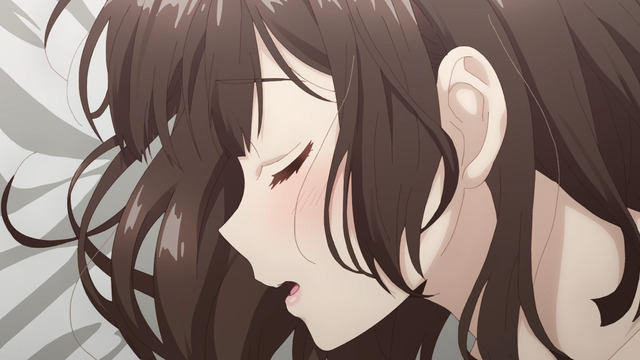
HigeHiro showed Sayu orgasming on screen.
Of course, the real reason Yoshida never asks is because the story can't let him or the audience know before the narrative is ready. It turns out the unpleasant situation Sayu fled wasn't that bad, but that's the case only because HigeHiro insists on rehabilitating its antagonists immedately after introducing them. This sort of cowardice is a significant weakness of HigeHiro, as it makes its conflicts fairly hollow. The challenges presented in KoiKimo are not intractable either, but at least they don't take on a fraudulent quality.
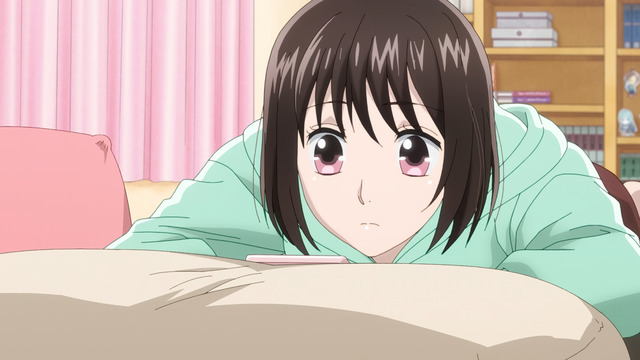
Ichika grew accustomed Ryo's nightly calls without realizing it.
KoiKimo succeeded by being forthright about its romance and committing to it unapologetically. In contrast, HigeHiro (like Yoshida himself) spends basically the entire series maintaining an unconvincing veneer of plausible deniability over whether or not Sayu is an actual love interest. At the risk of attracting accusations of being in favor of age-inappropriate pairings, I'm going to suggest HigeHiro does this to its detriment.
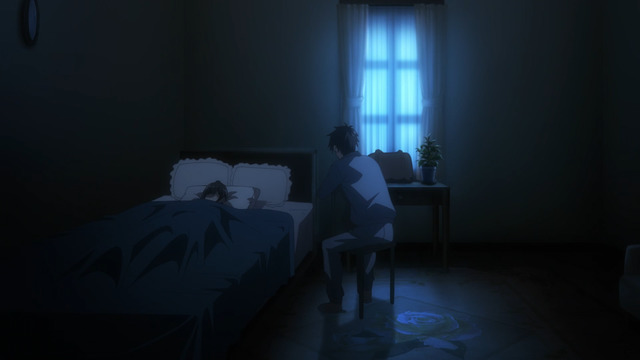
They had to put him in a chair watching her sleep
so people wouldn't insist they still fucked.
I suppose I can't speak for its source material, but the anime most certainly portrays Sayu as an eligible partner. Does HigeHiro provide Sayu with agency by having her test Yoshida's resolve each time she propositions him? Or does the series undermine Sayu's agency by presenting these moments solely so Yoshida can continue to rebuff her and showcase his unflagging integrity? I'm not answering this rhetorical, but I think we all know.
Posted in Hige wo Soru. Soshite Joshikousei wo Hirou., Koi to Yobu ni wa Kimochi Warui | Tags: 16-year-old love interests, Bad Things Happen to Good People, Bend Her Over a Kotatsu, Built for Sin, Christmas Cake, Compare and Contrast, Fan Service, Hanakana Distortion Field, Hanazawa Kana, Harem Comedy, Light Novels, Love Confessions, Love Triangle, Manga, May-December Romances, Plying Girls, Rape, Romance, Season Conclusion, Sex, Spoilers, Spring 2021, tsundere, Unrequited Love | Permanent Link
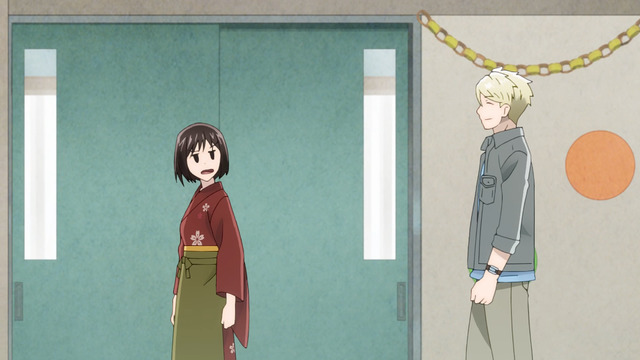
Stalker distancing.
News that the Spring 2021 anime season would feature TWO shows about adult men paired with high school girls created ripples across the Twitter, but even this mild outrage waned after viewers discovered neither show was as torrid as anticipated. Descriptions of Koi to Yobu ni wa Kimochi Warui (It's Disgusting to Call This Love, A.K.A. Koikimo) in particular concentrated on elements that ranged from misleading (characterizing its male lead as "a womanizer") to outright untruthful (e.g., calling him "sex-crazed...with a wandering eye for women"). At the risk of stereotyping too much, I suspect more attention should have been paid to the fact that the Koikimo manga is described as josei (i.e., for adult women) instead of seinen (i.e., for adult men who miss fucking teenage girls).
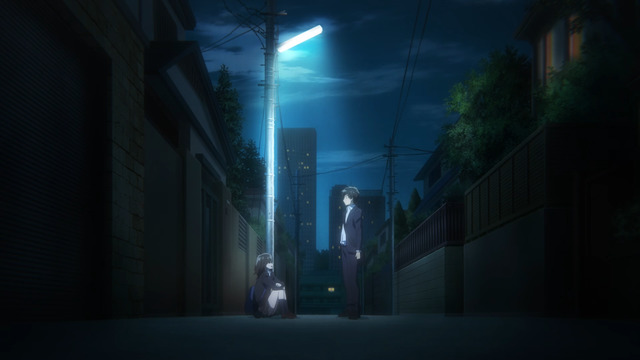
I was too bothered by Sayu's lack of luggage to make a Fate/stay night joke.
Curiously, Hige wo Soru. Soshite Joshikousei wo Hirou. (Higehiro: After Being Rejected, I Shaved and Took in a High School Runaway) seemed to attract less pre-season attention than Koikimo, but perhaps its original novels and manga adaption were already known well enough to deflect unwarranted speculation that it was going to be a smutty romp. This, despite its synopsis outright stating that its characters meet when the titular teenage girl, Sayu, offers sex in exchange for a place to stay. Instead, Higehiro is about a man, Yoshida, who insists he is not attracted to the JK crashing at his place. The series begins with Yoshida being rejected by his long-term crush (his boss at work, no less) who claims she is already seeing someone. He is so devastated that he seemingly does not even notice she was CLEARLY LYING.
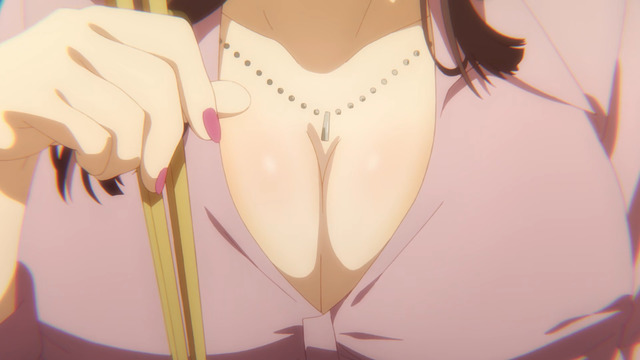
Dude, you're staring.
Higehiro also draws attention to Yoshida's insistence that he is not a "nice guy" for letting Sayu live with him without strings attached (unlike everyone else she has stayed with during her previous six months as a runaway), but rather that the other men she has known are despicable people. Yoshida also repeatedly insists he is not attracted to Sayu because he only likes women with large breasts, but then the show promptly undercuts him by immediately alerting (and repeatedly reminding) the viewer that Sayu's boobs are also comfortably big.
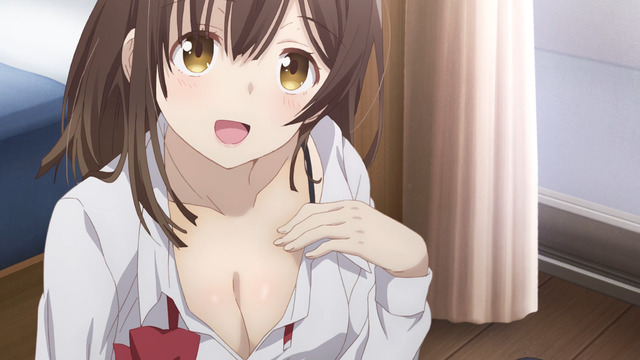
Higehiro even quantifies the comparison.
This is where I lose the ability to predict the path Higehiro will take. There is enough fan service and "male gaze" to the anime that we are obviously supposed to see Sayu as a legitimate love interest of Yoshida's, despite (or perhaps because of) his loud denials. But the show also retains the harem elements by keeping the CLEARLY LYING boss lady and deliberately slapdash co-worker near as potential romantic rivals. If I had to guess how this story ends, I would expect Yoshida's support to put Sayu on a path to success before re-uniting the two after a multi-year timeskip apart that has given Sayu time to become a self-sufficient adult with even bigger boobs than ever. Alternatively, we'll get a cop-out non-ending ending, potentially with all four of them living together for contrived reasons.
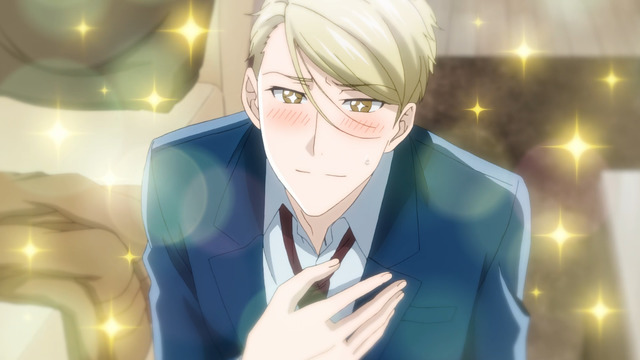
You can tell he's sincere because of the sparkles.
While Higehiro is about a man who denies being attracted to the teenage girl living with him, Koikimo is about a man openly and aggressively wooing a high school girl 10 years his junior. At this point, I think it is necessary to acknowledge the tropes that govern this story's boundaries. Ryo and Ichika meet by chance and a suspension bridge moment sparks his sudden obsession with Ichika, who is coincidentally classmates with Ryo's kid sister, Rio. Fortunately for Ryo, his sister not only approves of his infatuation with her friend, but even volunteers as his wingman to provide opportunities for him to get closer with Ichika.
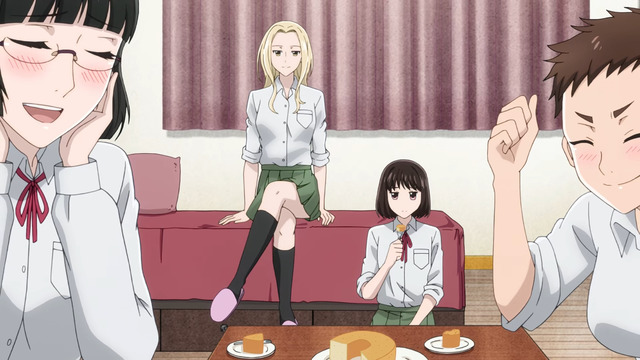
Rio's anime bed is made of concrete.
Moreover, Ichika's own mother approves of Ryo's courtship, despite Ichika's clear displeasure. It is probably worth pointing out that Ryo has apparently never had to pursue a love interest before. He is not a pick-up artist chasing after fresh prey. Instead, girls and women have thrown themselves at him his entire life (Ichika's and Rio's classmates all unanimously agree Ryo is exceptionally handsome), so this is an entirely new experience for him.
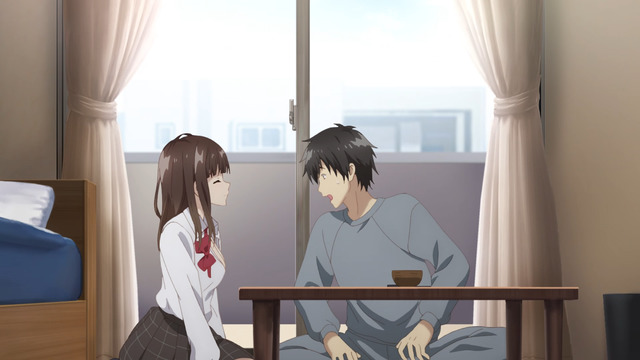
Dude, you're staring.
So what are Koikimo and Higehiro both missing? Lust. In the case of Koikimo, Ryo is clearly, genuinely smitten with Ichika, but he is arguably more drawn to her disinterest in him than he is to her physical appearance. Ichika is presented as being fairly unremarkable among her peers, and her own best friend describes her as "normal" (although at least one boy at her school has taken a liking to her). In the case of Higehiro, it takes three episodes of the show loudly signalling that Sayu is comely and sexually available before Yoshida finally admit he finds her attractive. However, his refusal to sleep with her is predicated on a critical, foundational cornerstone to the narrative's integrity, so I don't expect the story can too easily reverse this stance even if the audience comes to think he protests too much.

She is upset because she is pleased.
After four episodes of Koi to Yobu ni wa Kimochi Warui and three episodes of Hige wo Soru. Soshite Joshikousei wo Hirou., I enjoy Koikimo more than Higehiro. Neither series is especially realistic (although I could believe Higehiro, despite the melodrama, were it not for the CLEARLY LYING Christmas-cake boss lady and the co-worker who deliberately fucks up her work for Yoshida's attention), but I find Koikimo more amusing. I can't rule out the possibility that I'm simply more enamored of Ichika's seemingly endless barrage of disgusted faces than I am with Sayu's "pretty big for a high school girl" bosom, though.
Posted in Hige wo Soru. Soshite Joshikousei wo Hirou., Koi to Yobu ni wa Kimochi Warui | Tags: 16-year-old love interests, Bend Her Over a Kotatsu, Built for Sin, Christmas Cake, Compare and Contrast, Harem Comedy, Light Novels, Love Confessions, Love Triangle, Manga, May-December Romances, Plying Girls, Rape, Romance, Season Introduction, Sex, Spring 2021, tsundere, Twitter, Unrequited Love | Permanent Link
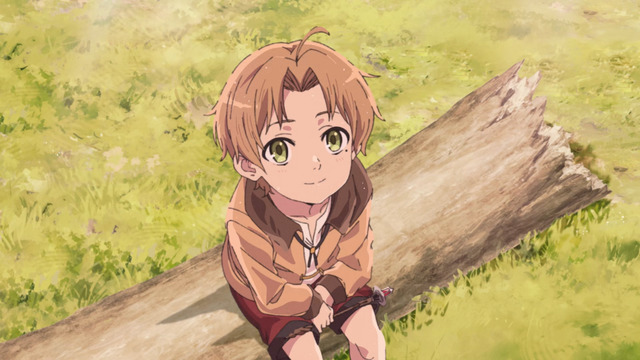
Would he still have ended up a shithead anyway if he didn't have incredible magic powers?
I was first introduced to Mushoku Tensei: Isekai Ittara Honki Dasu (Mushoku Tensei: Jobless Reincarnation or Jobless Reincarnation: I Will Seriously Try If I Go To Another World) years ago when it was only a web novel. Specifically, every single thing I heard about it made it sound terrible, even from readers who enjoyed it. In particular, the protagonist (named Rudeus in his new life) sounded about as despicable as you can make a character, at least according to secondhand sources.
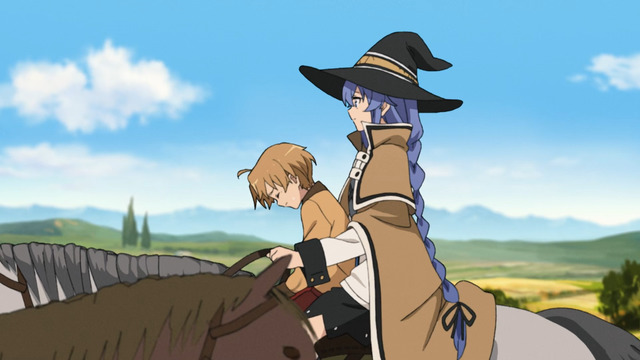
Roxy thinks Rudy only has crippling equine anxiety.
The second episode of the anime adaptation focuses a fair amount on the trauma that led to Rudy becoming a hikkikomori in his previous life. Even as a five-year-old boy in his new life, severe anxiety prevents him from leaving his home or making eye contact with villagers in the countryside. He does seem to get over it, thanks to the assistance of his live-in magic tutor who has befriended the neighbors during the course of her stay. I suppose this does inspire some degree of sympathy, since the anime depicts the bullying he suffered from his point of view and without any context. Still, it's not clear what transpired between his school days and adulthood. We learn he gets kicked out after staying home to masturbate instead of attending his parents' funeral, but it's less clear how he got there, and it's unknown what sort of course corrections—if any—he attempted during his life before reaching that point. The bullying is not enough for me to just give him a pass. In any case, the anime hasn't dwelled too much on his past (at least not yet), probably to its benefit.
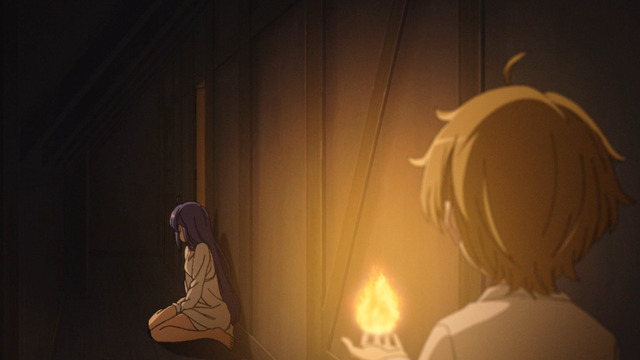
I sort of think Roxy would have noticed this.
The anime does continue to portray him as a perverted child, but there's not any comedic value in it. I presume these scenes are there to help establish a baseline that includes his pre-reincarnation persona and will thereby underscore progress that he makes later in this two-cours series. I'm mostly ambivalent about Rudeus at this point, so that's relatively positive considering I was expecting to loathe him. The anime itself still looks really nice, so I imagine fans of the books must be pleased with how it's turning out. I don't know that I'm going to stick around for two cours of this, but the show seems all right so far. I was expecting more questionable creative choices in the writing, but it seems those impressions may have been web-novel baggage that Mushoku Tensei is not dragging with it into the anime, at least not so far.
Posted in Mushoku Tensei: Isekai Ittara Honki Dasu | Tags: Douche Bags, Fat Anime Characters, First Girl He Sees Clause, Initial impressions, Light Novels, Season Introduction, Sex, Winter 2021 | Permanent Link
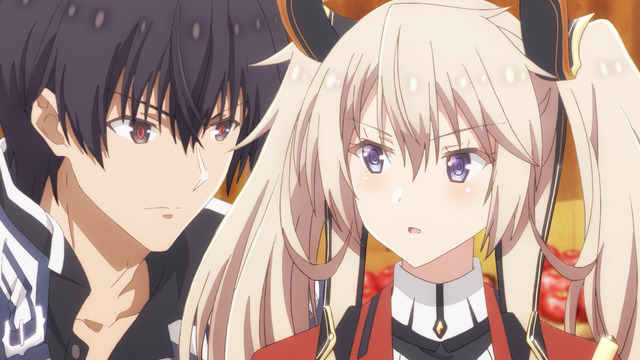
If you keep making eye contact like that, she's gonna do the thing.
I started watching Maou Gakuin no Futekigousha (The Misfit of Demon King Academy) because I like the way its character designer draws eyes. True story. (This is also why I watched Toji no Miko (Katana Maidens. But I digress.) As it turns out, the Maou Academy anime has stayed reasonably entertaining through its first nine episodes, and about in line with what I hoped for after the first two episodes.
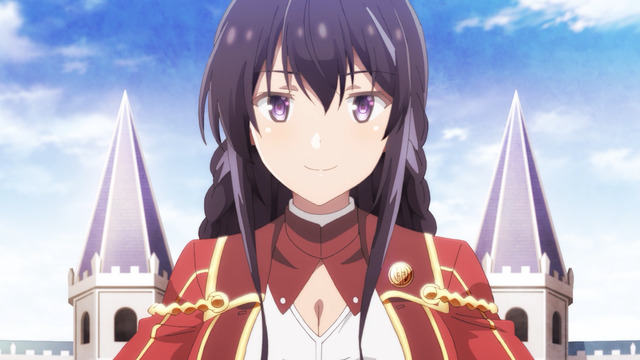
It took nine episodes to introduces this twin-braided character from the promo art.
One key to its success is having enough lore to keep the viewer guessing as to what's happened in the world during the two thousands years Anos was busy staying dead. Or rather, enough lore to make it interesting, but not so much lore that it becomes oppressingly sonorous. (Fate/stay night, I am looking in your direction.) I don't think anyone is going into Maou-kun Goes to Maou-kun School expecting the best thing ever, but anyone in the mood for casually lopsided fights and a fair amount of tsundere yammering has come to the right place.
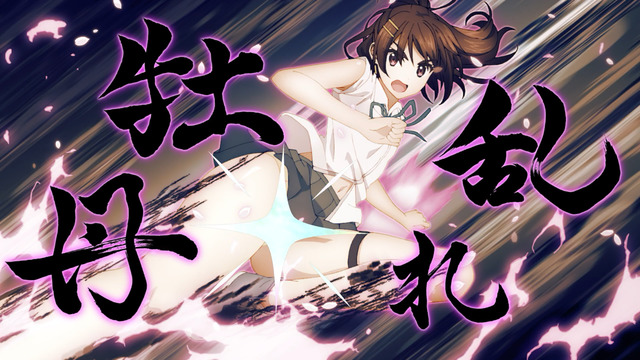
I don't know why they censored this. She's wearing panties.
Since I first introduced Maou Gakuin together with Dokyuu Hentai HxEros (SUPER HXEROS), I guess I should also include that I dropped HXEROS after five episodes. It is what it is, but there were other things I preferred to spend my time on instead.
Posted in Dokyuu Hentai HxEros, Maou Gakuin no Futekigousha | Tags: Built for Sin, Childhood Friend, Dropped Shows, Fan Service, Harem Comedy, Light Novels, Nudity, Sex, Summer 2020, Superlovely Character Designs, tsundere | Permanent Link
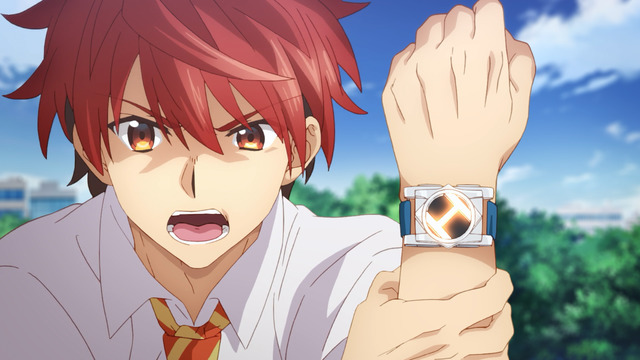
I bet this watch doesn't even keep time.
The Summer 2020 anime season is upon us, and the first shows I watched were Dokyuu Hentai HxEros (SUPER HXEROS) and Maou Gakuin no Futekigousha (The Misfit of Demon King Academy). These were not exactly shows I was looking forward to seeing, but they were among the ones first out the gate, so why not? As it turns out, neither are as bad as I might have feared, although I can't exactly call them good either.
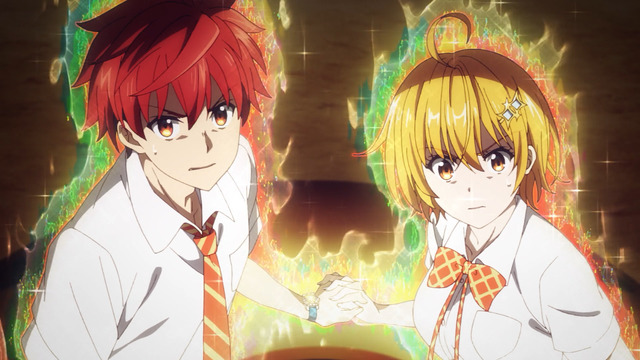
Ol' Red here is literally powered by this blonde girl's indefatigable libido.
In the case of Dokyuu Hentai HxEros, there have been multiple anime in the past that involved teenagers harnessing the power of their youth to battle various evildoers. Dakara Boku wa, Ecchi ga Dekinai. (So, I Can't Play H!) comes to mind, as does Hybrid × Heart Magias Academy Ataraxia (i.e., the other HxH anime—the one that is not Hunter x Hunter). SUPER HXEROS was actually sort of amusing thanks to its embrace of tokusatsu live-action tropes. The show is self-aware, but not to a negative extent.
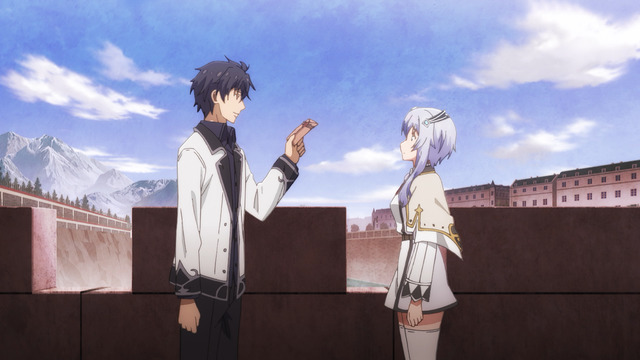
Picking up The Precious Thing is apparently a big deal in Misha's eyes.
I'm expecting Maou Gakuin no Futekigousha to be light-novel rubbish, but I genuinely appreciate that the first episode skipped the backstory and setup entirely, dropping the reader straight into the reincarnated demon king's first day at Evil Hogswarth. (Okay, fine, at a slightly eviler Hogswarth.) The characters at school are entirely forgettable so far, and exist mostly so the "misfit demon king" has various assholes he can easily defeat. (They totally have it coming.) His parents seem really dumb, but in a good-natured sort of way, so I'm willing to watch more. Overall, not a great start to the Summer 2020 anime season, but good enough for its first week.
Posted in Dokyuu Hentai HxEros, Hybrid × Heart Magias Academy Ataraxia, Maou Gakuin no Futekigousha | Tags: Built for Sin, Childhood Friend, Fan Service, First Episode, Harem Comedy, Light Novels, Season Introduction, Sex, Summer 2020, Superlovely Character Designs | Permanent Link

Iwanaga is not a chuuni. She's probably just re-adjusting her eye.
Although I really enjoyed the In/Spectre (Kyokō Suiri, or Invented Inference) anime, I was surprised at long the "Steel Lady Nanase" arc lasted. (Specifically, it takes up the entire rest of the cours once it starts.) I'm reading the manga now, and these volumes include afterwords by the original author that shed light on the situation.
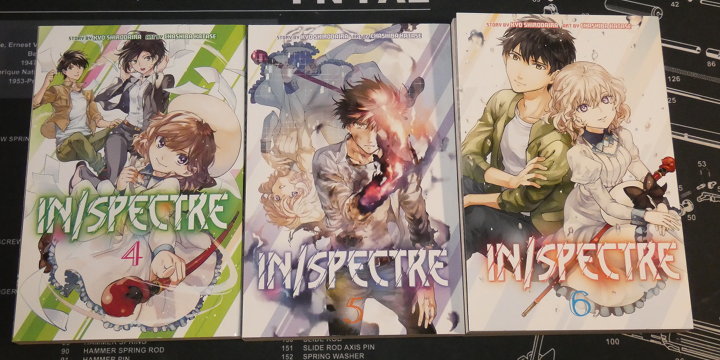
Despite appearance, Kuro is also not a chuuni. He is tsundere for his own girlfriend, though.
Kyokou Suiri was originally one book. This received a manga adaptation which spanned six volumes. The author claims he gave the mangaka essentially full control over the visuals and a lot of latitude to apply appropriate changes while adapting the book to manga form. This hands-off approach seems to have worked, as the manga proved popular enough to inspire the original author to write more stories (while lamenting the Invented Inference title no longer really fit the subject matter of the later material).
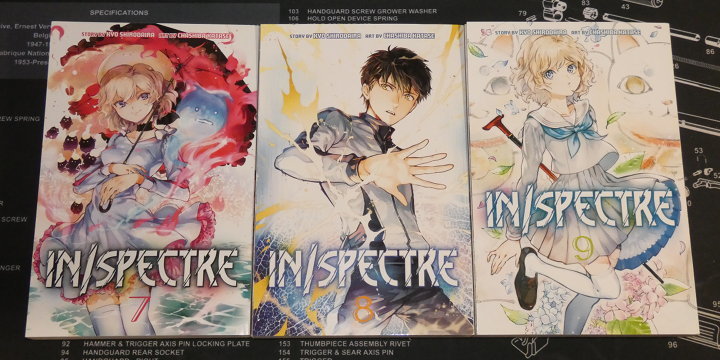
Iwanaga is wearing a school uniform because one of the stories takes place while she was in high school.
Notably, the original author (Shirodaira Kyo) wrote the subsequent material as short stories, rather than collaborating with the mangaka (Katase Chasiba) to produce scripts for the manga, reasoning that doing things differently at this point could inadvertently disrupt the chemistry of whatever it was that made the manga adaptation of the original book turn out so well. Well, he wasn't wrong. The five volumes following the "Steel Lady Nanase" arc are at least as good, if not better.
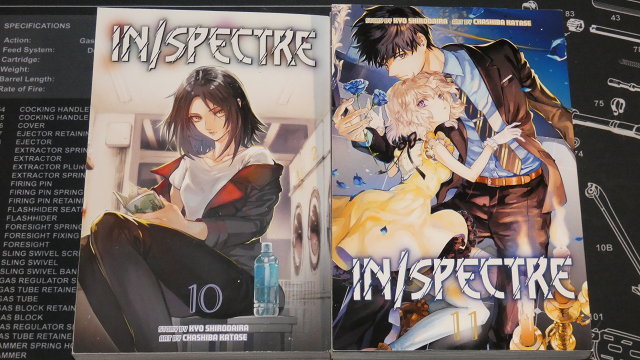
Rikka's not dead, she just looks like that.
As you may have guessed, the In/Spectre anime is itself an adaptation of the manga, and not a separate adaptation of the original book (which I've not had an opportunity to read). As adaptations go, it's very close, really only moving the arc with the giant snake so that it takes place before the Steel Lady Nanase arc instead of after it. I don't know if there are any plans to produce a sequel to the anime, but there is certainly enough source material to support one. All of the subsequent stories in the volumes I've read are shorter than the Steel Lady Nanase one, but at least three of them are long enough to span multiple episodes. Thankfully, the longest of these concluded at the end of volume 11, instead of with a cliffhanger leaving the reader waiting until the release of volume 12—that one won't be out until the end of August.
Posted in In/Spectre, Literature, Loot, Manga | Tags: Bad Things Happen to Good People, Bend Her Over a Kotatsu, Detectives, Hair, Idols, Love Confessions, Mysteries, Sex, tsundere, Unrequited Love, Winter 2020 | Permanent Link
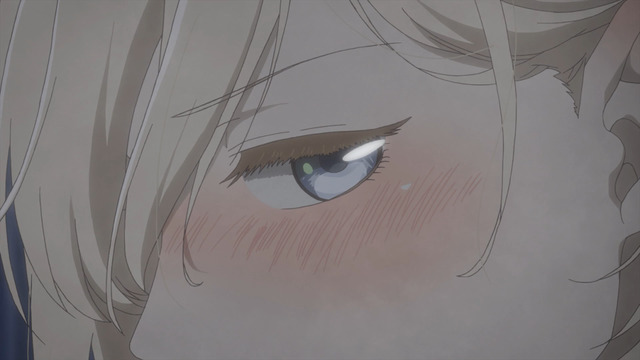
Lewd.
I suppose I need to set aside my anti-Okada bias now that I've enjoyed one of her melodramas so much. As far as sex disasters go, Araburu Kisetsu no Otomedomo yo。 was honestly a little light on the sex and not as traumatic in the disaster department as I would have liked, but O Maidens in Your Savage Season did have the courage to do a lot of things that I don't think an Okada-free show would have attempted. Framed in the sense that tragedies end in murder while comedies end in marriage. I was optimistically hoping Araoto would turn out to be a tragedy, but I still liked it quite a bit even though it turned out to be a comedy.
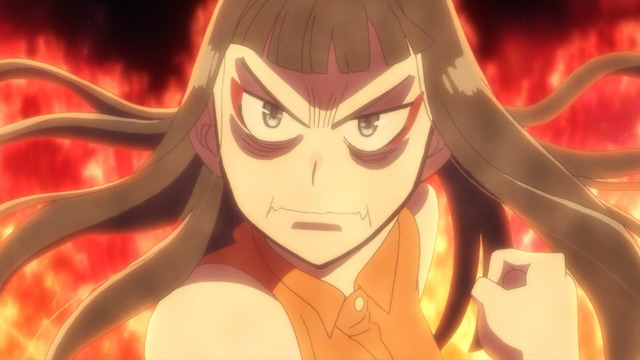
Relax, it's only lust.
Not that there wasn't tragic stuff in it, but we're talking emotional-trauma tragic, not murder-suicide tragic. I do wish Araburu Kisetsu no Otomedomo yo。 had not gone quite so easy on the arcs that had the best opportunities for going really poorly for everyone involved, but I acknowledge this is a sadistic perspective. Besides, fully exploring some of the paths that its characters could have taken would have changed the tone of the show dramatically. Probably I still would have been entertained, but I appreciate that many viewers would not have been as accepting. Still, I don't think it's entirely unreasonable to hope an Okada Mari sex disaster would end with a murder instead of a marriage. I'm just sayin'.
Posted in Araburu Kisetsu no Otomedomo yo。 | Tags: Bend Her Over a Kotatsu, Fat Anime Characters, Love Confessions, Love Triangle, Manga, Plying Girls, Romance, Season Conclusion, Sex, Summer 2019, tsundere, Unrequited Love | Permanent Link
|
|







